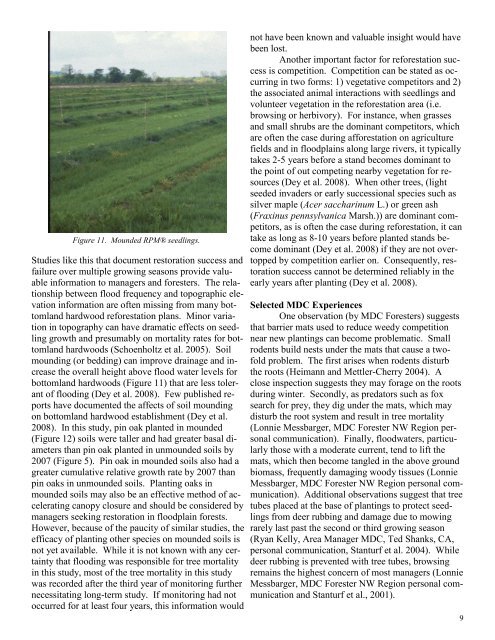Science and Management Technical Series_vol1_final.pdf - Upper ...
Science and Management Technical Series_vol1_final.pdf - Upper ...
Science and Management Technical Series_vol1_final.pdf - Upper ...
Create successful ePaper yourself
Turn your PDF publications into a flip-book with our unique Google optimized e-Paper software.
Figure 11. Mounded RPM® seedlings.<br />
Studies like this that document restoration success <strong>and</strong><br />
failure over multiple growing seasons provide valuable<br />
information to managers <strong>and</strong> foresters. The relationship<br />
between flood frequency <strong>and</strong> topographic elevation<br />
information are often missing from many bottoml<strong>and</strong><br />
hardwood reforestation plans. Minor variation<br />
in topography can have dramatic effects on seedling<br />
growth <strong>and</strong> presumably on mortality rates for bottoml<strong>and</strong><br />
hardwoods (Schoenholtz et al. 2005). Soil<br />
mounding (or bedding) can improve drainage <strong>and</strong> increase<br />
the overall height above flood water levels for<br />
bottoml<strong>and</strong> hardwoods (Figure 11) that are less tolerant<br />
of flooding (Dey et al. 2008). Few published reports<br />
have documented the affects of soil mounding<br />
on bottoml<strong>and</strong> hardwood establishment (Dey et al.<br />
2008). In this study, pin oak planted in mounded<br />
(Figure 12) soils were taller <strong>and</strong> had greater basal diameters<br />
than pin oak planted in unmounded soils by<br />
2007 (Figure 5). Pin oak in mounded soils also had a<br />
greater cumulative relative growth rate by 2007 than<br />
pin oaks in unmounded soils. Planting oaks in<br />
mounded soils may also be an effective method of accelerating<br />
canopy closure <strong>and</strong> should be considered by<br />
managers seeking restoration in floodplain forests.<br />
However, because of the paucity of similar studies, the<br />
efficacy of planting other species on mounded soils is<br />
not yet available. While it is not known with any certainty<br />
that flooding was responsible for tree mortality<br />
in this study, most of the tree mortality in this study<br />
was recorded after the third year of monitoring further<br />
necessitating long-term study. If monitoring had not<br />
occurred for at least four years, this information would<br />
not have been known <strong>and</strong> valuable insight would have<br />
been lost.<br />
Another important factor for reforestation success<br />
is competition. Competition can be stated as occurring<br />
in two forms: 1) vegetative competitors <strong>and</strong> 2)<br />
the associated animal interactions with seedlings <strong>and</strong><br />
volunteer vegetation in the reforestation area (i.e.<br />
browsing or herbivory). For instance, when grasses<br />
<strong>and</strong> small shrubs are the dominant competitors, which<br />
are often the case during afforestation on agriculture<br />
fields <strong>and</strong> in floodplains along large rivers, it typically<br />
takes 2-5 years before a st<strong>and</strong> becomes dominant to<br />
the point of out competing nearby vegetation for resources<br />
(Dey et al. 2008). When other trees, (light<br />
seeded invaders or early successional species such as<br />
silver maple (Acer saccharinum L.) or green ash<br />
(Fraxinus pennsylvanica Marsh.)) are dominant competitors,<br />
as is often the case during reforestation, it can<br />
take as long as 8-10 years before planted st<strong>and</strong>s become<br />
dominant (Dey et al. 2008) if they are not overtopped<br />
by competition earlier on. Consequently, restoration<br />
success cannot be determined reliably in the<br />
early years after planting (Dey et al. 2008).<br />
Selected MDC Experiences<br />
One observation (by MDC Foresters) suggests<br />
that barrier mats used to reduce weedy competition<br />
near new plantings can become problematic. Small<br />
rodents build nests under the mats that cause a twofold<br />
problem. The first arises when rodents disturb<br />
the roots (Heimann <strong>and</strong> Mettler-Cherry 2004). A<br />
close inspection suggests they may forage on the roots<br />
during winter. Secondly, as predators such as fox<br />
search for prey, they dig under the mats, which may<br />
disturb the root system <strong>and</strong> result in tree mortality<br />
(Lonnie Messbarger, MDC Forester NW Region personal<br />
communication). Finally, floodwaters, particularly<br />
those with a moderate current, tend to lift the<br />
mats, which then become tangled in the above ground<br />
biomass, frequently damaging woody tissues (Lonnie<br />
Messbarger, MDC Forester NW Region personal communication).<br />
Additional observations suggest that tree<br />
tubes placed at the base of plantings to protect seedlings<br />
from deer rubbing <strong>and</strong> damage due to mowing<br />
rarely last past the second or third growing season<br />
(Ryan Kelly, Area Manager MDC, Ted Shanks, CA,<br />
personal communication, Stanturf et al. 2004). While<br />
deer rubbing is prevented with tree tubes, browsing<br />
remains the highest concern of most managers (Lonnie<br />
Messbarger, MDC Forester NW Region personal communication<br />
<strong>and</strong> Stanturf et al., 2001).<br />
9


